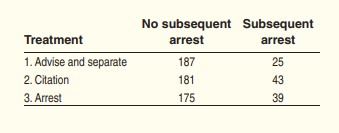A study conducted in Charlotte, North Carolina, tested the effectiveness of three police responses to spouse abuse: (1) advise and possibly separate the couple, (2) issue a citation to the offender, and (3) arrest the offender. Police officers were trained to recognize eligible cases. When presented with an eligible case, a police officer called the dispatcher, who would randomly assign one of the three available treatments to be administered. There were a total of 650 cases in the study. Each case was classified according to whether the abuser was subsequently arrested within six months of the original incident.

(a) Explain the purpose of the random assignment in the design of this study.
(b) Construct a well-labeled graph that is suitable for comparing the effectiveness of the three treatments.
(c) We want to use these data to perform a test ofwhere
the true proportion of spouse abusers like the ones in this study who would be arrested again within six months after receiving treatment \(i\). State an appropriate alternative hypothesis.
(d) Assume that all the conditions for performing the test in part (b) are met. The test yields and a P-value of Interpret this P-value in context. What conclusion should we draw from the study?





